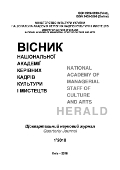THE PECULIARITY OF THE INTERPRETATIVE THINKING IN THE CONTEXT OF RHETORIZED PIANO PERFORMING STYLE
DOI:
https://doi.org/10.32461/2226-3209.1.2018.160350Keywords:
style, interpretation, piano, baroque, composer’s style, numinal accents, M. Yudina, G. GouldAbstract
The purpose of this article consists in disclosing the particularity of the interpretative thinking of the representatives of the rhetorized piano performing style based on the analysis of M. Yudina’s and G. Gould’s interpretations, which belong to this style of piano performing. The research methodology is based on the system approach and on the comparative-historical (to reveal the peculiarities of appearance of different style epochs in piano performing) and historical -stylistic (to research the specifics of composer and performer styles during a particular historical period) methods modified accordingly to the peculiarities of the subject. The scientific novelty of this article consists in the developing of a programmatic view on the piano performing interpretation from the position of unity of the manner of presenting the composer’s style as subject of performer’s thinking and music perception based on the creative work of pianists belonging to the rhetorized performing style. Conclusions. Based on the analysis of M. Yudina’s and G. Gould’s interpretations, it is possible to conclude that the work of the representatives of the rhetorized piano performing style can be characterized by the equal presence of the sensory and mental functions on the foreground. This is due to the fact that the rhetorized piano performing style itself relies on the affection that is directly related to linguistic intonation and the search for expressive means of musical intonation. Affection as a way of thinking involves presenting emotion in a straight and rationalized form. Such an emphasis results in the balance of emotional and rational principles and leads to expressive affection and creation of “spiritualized symbols” of the piano performance. Therefore, the representatives of the rhetorized piano performing style are referred to the emotional-logical type of interpretative thinking, the essence of which is the equivalence of sensory and mental functions. Depending on the personal traits of the performers, this interpretation type can be of both extroverted (M.Yudina) and introverted (G.Gould) directions.
References
Арановский М.Т. Мышление, язык, семантика / М.Т. Арановский// Проблемы музыкального мышления: [сб. ст. / общ. ред. М.Арановского]. – М.: Музыка, 1974. – С. 90-128.
Григорьев Л. Современные пианисты: [cб. крат. биогр.] / Л. Григорьев, Я. Платек. – М.: Сов.композитор, 1990. – 463 с.
Коган Г. Вопросы пианизма / Г.Коган. – М.: Сов. композитор, 1968. – 491 с.
Корыхалова, Н.П. Интерпретация музыки: Теоретические проблемы музыкального исполнительства и критический анализ их разработки в современной буржуазной эстетике / Н.П. Корыхалова. – М.: Музыка, 1979. – 208с.
Рабинович Д. Исполнитель и стиль / Д. Рабинович. – М.: Сов. композитор, 1981. – 229 с.
Скорбященская, О. Гульдианство как миф / О. Скорбященская // Аудио Магазин. – 2000. – №3 (32). –С.89-92.
Флоренский, П.А. Анализ пространственности и времени в художественно-изобразительных произведениях /П.А.Флоренский священник // Статьи и исследования по истории и философии искусства и археологии / П.А.Флоренский – М. : Мысль, 2000. – С. 79–421.
Юдина М.В. Статьи, воспоминания, материалы / М.В.Юдина. – М. : Сов. композитор, 1978. – 416 с.
Aranovskiy, M.T. (1974). Thinking, language, semantics. Problemy muzykalnogo myshleniya, 90–128 [in Russian].
Grigoriev, L., Platek, Ja. (1990). Modern pianists. Moskva:Sov. Kompozitor [in Russian].
Kogan, G. (1968). Questions of pianism. Moskva:Sov. Kompozitor [in Russian].
Koryhalova, N.P. (1979). Interpretation of music. Theoretical problems of musical performance and critical analysis of their development in modern bourgeois aesthetics. Moskva:Muzyka [inRussian].
Rabinovich, D. (1981). Artist and style. Moskva:Sov. kompozitor [in Russian].
Skorbyaschenskaya, O. (2000). Guldianism as a myth. AudioMagazin, 3 (32), 89–92 [in Russian].
Florensky, P.A. (2000). Analysis of spatiality and time in artistic and visual works. Stat.issledovaniya po istoriii filosofii i iskusstva i arheologii, 79–421 [in Russian].
Judina, M.V. (1978). Articles, memoirs, materials. Moskva:Sov. kompozitor [in Russian].
Downloads
Published
Issue
Section
License
Authors who publish with this journal agree to the following terms:
1. Authors retain copyright and grant the journal right of first publication with the work simultaneously licensed under a Creative Commons Attribution License International CC-BY that allows others to share the work with an acknowledgement of the work's authorship and initial publication in this journal.
2. Authors are able to enter into separate, additional contractual arrangements for the non-exclusive distribution of the journal's published version of the work (e.g., post it to an institutional repository or publish it in a book), with an acknowledgement of its initial publication in this journal.
3. Authors are permitted and encouraged to post their work online (e.g., in institutional repositories or on their website) prior to and during the submission process, as it can lead to productive exchanges, as well as earlier and greater citation of published work (See The Effect of Open Access).


